
Is crime on the rise in Arlington? It depends on which Arlington County official you ask.
Police Chief Andy Penn told the County Board last Thursday that crime rates rose in 2022, driven by upticks in theft — of cars and from cars — and assaults, largely in Arlington’s most populated neighborhoods. He noted that ACPD is seeing more crimes where a weapon is used.
Arlington started 2023 with a rise in carjackings and student overdoses, and this early data indicates that it ended 2022 with a nearly 23% increase in property crimes over 2021 with, specifically, a 27.4% increase in larcenies. In addition, there has been a nearly 32% increase in vehicle thefts and a 14% increase in thefts from vehicles, especially with unlocked cars or those with keys left inside.
There has also been a 16% increase in crimes against people, such as assault, and a 21.5% decrease in crimes against society, such as drug violations.
Penn noted officers are seeing “more guns than what’s normal,” as officers seized 147 firearms in 2022 — an increase from 126 in 2021 and 104 in 2020. Of the seizures in 2022, 15 were ghost guns.
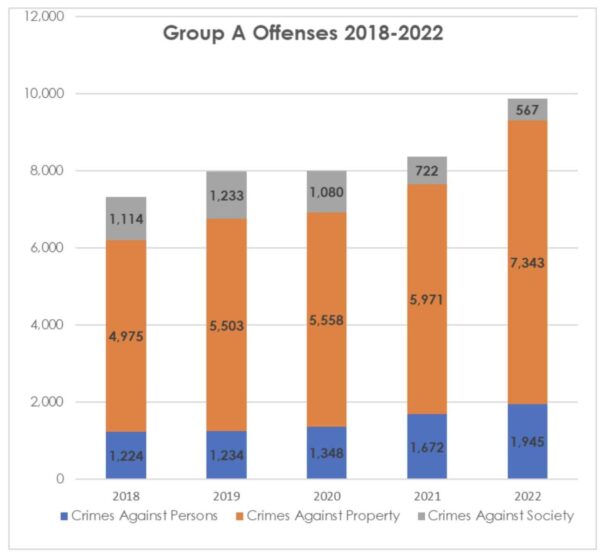
ACPD does not typically report arrest numbers — as opposed to offense numbers, which are released annually — for the most common group of offenses, which span everything from burglary to murder. A department spokeswoman told ARLnow that that would have to be requested through a Freedom of Information Act request.
The department noted its 2021 annual report, released last summer, that people officers have arrested for these “Group A” crimes are “frequently responsible for multiple cases within Arlington or regionally.”
The question of whether crime is rising in Arlington has implications for the race to determine the upcoming Commonwealth’s Attorney race. Josh Katcher, who used to work for the incumbent top prosecutor, Parisa Dehghani-Tafti, has made his campaign about acknowledging that crime is rising and criticizing his opponent for, he says, not admitting this.
“We can’t begin to address these issues until we are willing to acknowledge and face them head on,” he said in a statement to ARLnow. “Arlington County deserves a Commonwealth’s Attorney who is transparent with those that they are elected to serve. My opponent has repeatedly and publicly stated that crime has not been rising, starting in November of last year.”
Dehghani-Tafti, who won in 2019 on a platform of criminal justice reform, has maintained her position despite crime concerns from some residents and members of ACPD. In a statement to ARLnow in response, Dehghani-Tafti called Katcher’s rhetoric fear-mongering.
“Real leaders don’t engage in right wing fear mongering propaganda, particularly when Arlington remains one of the safest communities in the country,” she said. “Real leaders also don’t use right wing attack lines that prosecutors are responsible for temporary rise or decline in crime. While some categories of assaults have been on the rise since 2018, serious crimes such as homicides have declined in Arlington at the same time as jurisdictions nationwide have seen an increase.”
She noted that Arlington had zero homicides for nearly 18 months — one in February 2022 and none since then.
“Our job is to build on that success to continue to keep our community safe. That’s what I intend to do,” Dehghani-Tafti said.

Public safety in Arlington County is poised to be increasingly automated and unmanned, with more traffic enforcement cameras and drones potentially coming soon.
The updates came during a work session on County Manager Mark Schwartz’s proposed budget, attended by County Board members and heads of public safety departments yesterday (Thursday).
Installing new speed cameras and adding more red-light cameras are part of the county’s Vision Zero initiative to reduce serious injury and fatal crashes, as well as a recommended way to reduce potentially adverse interactions between officers and civilians during traffic stops.
Cameras and drones could also help the Arlington County Police Department work more efficiently with fewer officers, as ACPD has had to scale back services amid ongoing challenges with recruiting and retaining officers.
More than a year ago, the County Board approved the installation of speed cameras in school and work areas to reduce speed-related crashes in these areas as part of the Vision Zero campaign to eliminate traffic fatalities and injuries. Now, according to Police Chief Andy Penn, a contract with a speed camera vendor could be ready this spring.
Last fall, the county told ARLnow that there would be more signs of progress, including camera installation and community messaging, once a contract is finalized this spring. Penn told the County Board yesterday that a request for proposal for both speed cameras and more red-light cameras will close next week.
“My hope is that we’ll have a contract for both of those in the next couple of months,” Penn said.
Meanwhile, the police department is working with the Virginia Dept. of Transportation to expand locations with red-light cameras, according to Penn.
“We’re almost at the finish line with VDOT on the PhotoRED expansions, there’s a couple intersections… we should be there soon,” he said.
There are nine intersections that currently use PhotoRED cameras, according to the county’s website. These intersections are located along major corridors including Columbia Pike, Route 1, Glebe Road and Langston Blvd.
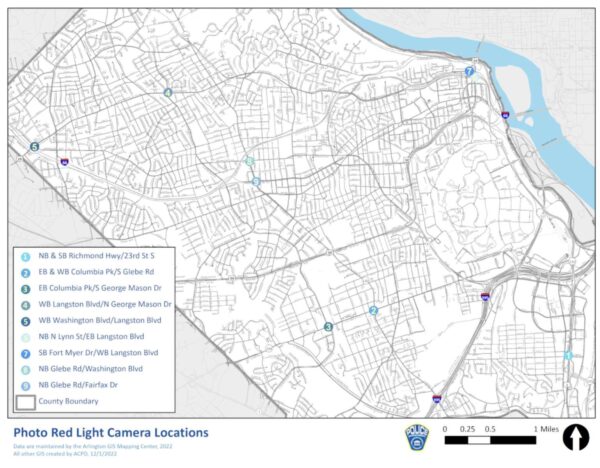
Arlington is also considering deploying drones, which could be a safety tool for both police and fire departments. Penn and Fire Chief Dave Povlitz told the Board they are focused on improving employee safety and wellbeing, which could bolster staffing levels.
“While we’re on equipment, drones? Are we thinking about drones?” asked Board Vice-Chair Libby Garvey. “It’d be a lot safer to send a drone in than a person into a burning building.”
After working with other jurisdictions in the region and conducting a survey, a comprehensive proposal on drones could be ready for Board review in “the next couple of months,” according to County Manager Mark Schwartz.
“They are fantastic additions to any fleet,” he said. “We absolutely would, in many cases, prefer — not just for fire but police and also for our building inspections — to have the ability to have drones.”
Police may already be using drones locally in some cases. One could be seen flying near the former Key Bridge Marriott in Rosslyn this morning as part of a large public safety agency presence at the aging building, which the county condemned amid the continued presence of squatters.
Two hurdles to greater drone use could be privacy and flight regulations governing drones in the region, Schwartz said.
“We want to make sure we address the privacy concerns, which I think have been successfully handled in other jurisdictions,” he said.
Unmanned aircraft flights, including drones, are heavily restricted within a 30-mile radius of Reagan National Airport, according to rules the Federal Aviation Administration put in place after 9/11. Drones need FAA authorization and have to operate under certain restrictions.
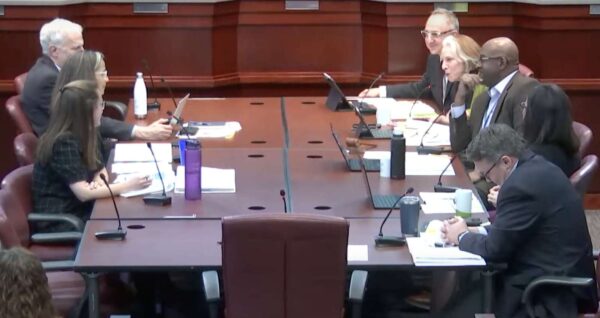
Arlington County’s Dept. of Parks and Recreation says it has a surfeit of programs for teens — but not enough teens to fill them.
Between July 2021 and June 2022, DPR logged 6,350 visits to its teen programs, down from 46,500 visits during the same span of months across 2018 and 2019. The dramatic drop was caused by the cancellation of programs during the 2021 fiscal year, according to County Manager Mark Schwartz’s proposed budget.
That year, DPR logged a low of 3,286 check-ins to teen programs. Now, the parks department is aiming to get those kids involved in activities once again. It projects 24,000 visits to teen programs in the next fiscal year.
“I think that, during the pandemic, a lot of teens reverted to their phones, to their rooms, and really didn’t get out into parks and into our centers,” Jane Rudolph, the director of the parks department, told Board members during a budget work session last week. “I look forward to working with our partners to get them back.”
The Arlington County Board is also motivated to see higher participation in these programs, which are geared toward preventing risky behavior and increasing physical activity, among other goals.
County Board members indicated they would like to see these programs figure into the county-wide effort to tackle the mental health and substance abuse epidemics affecting Arlington youth. Member Takis Karantonis kicked off a round of questions for Rudolph about how her department plans to boost offerings for teens and tweens.
“It’s not so much expanding the offerings but getting people into the programs we offer. That’s where we see our biggest challenges,” Rudolph said. “Where we need to do better, to be honest, is getting word out more about our programs, working better with schools so kids understand where they can come to us.”
Before the work session, ARLnow had asked DPR to share its offerings for teens and tweens. It provided a long list of offerings, including:
- “Out of School Time” programs daily at Gunston and Thomas Jefferson Community Centers
- More than 100 summer camps from exploring outdoors to coding, as well as volunteer and employment opportunities through other camps
- Esports, flag football and basketball leagues
- An annual soccer tournament in partnership with the Arlington County Police Department Gang Prevention Task Force
- DJ and music production classes
Recent community meetings on opioid use, however, encapsulate the gulf between what is offered and what the community actually knows about.
When a group of Latino parents convened the same week 14-year-old Wakefield High School student Sergio Flores died from an overdose, many parents did not know what options were available but seemed desperate for after-school programs and open recreation time at the school gyms, meeting organizers told ARLnow.
In another meeting ARLnow attended a few weeks later, at Kenmore Middle School, a representative from Arlington County Police Department asked the audience to guess how many programs the county has for youth. The answer was more than 300, but one parent challenged how helpful sheer volume if there is a lack of awareness and enrollment is a challenge.
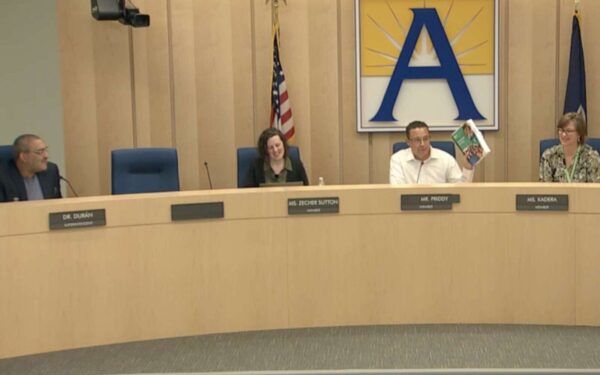
Arlington Public Schools Superintendent Francisco Durán has proposed an $803.3 million budget — an increase of more than 7% over the current budget.
And the messaging around the budget picks up on some themes, including the mental and physical health of students and more support for teachers, which arose from major events this school year, including a series of student deaths and drug overdoses.
“This budget reflects our commitment to supporting continued success for every APS student through investments in both academic and mental health support,” Durán said in a statement.
“We are also continuing our focus on compensation for our teachers and staff to ensure we remain a highly competitive employer at a vital time for public schools, while further strengthening division-wide safety and security measures,” he added.
Durán writes that the budget process for the 2023-2024 school year began with “a large deficit” after APS used some $41 million — partially from reserves — last year to avoid significant reductions.
“This deficit was also driven by the need to provide staff with a step increase as well as a cost of living adjustment next year in order to partially mitigate rising inflation,” he said.
Like last year, APS is once more drawing from its well of reserves, spending $41.2 million in addition to the county transfer of $607.6 million. This transfer, $23 million larger than last year, comprises three-quarters of the school system’s revenue.
Both enrollment and cost-per-pupil are on the rise, per the budget. Next year, APS projects enrollment to increase by 710 students, according to a six-page budget explainer, while per-pupil expenditures to reach $24,560.
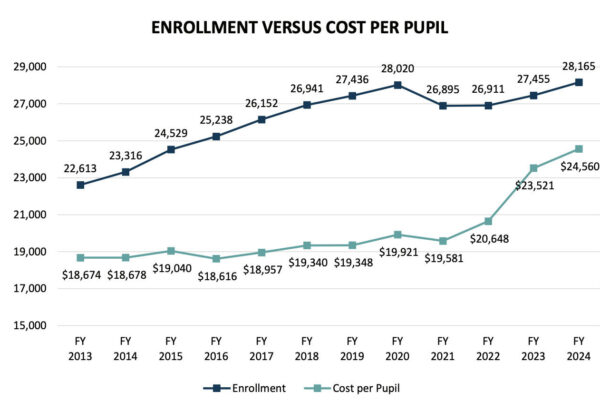
It also projects a rising number of students receiving special education services and learning English.
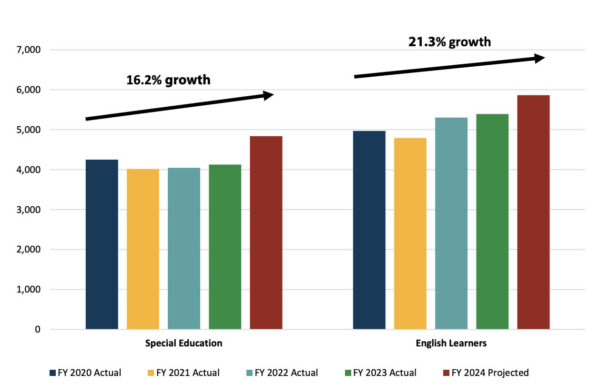
When it comes to school staff, the budget includes $25.6 million for step increases for eligible employees and a 3% cost of living adjustment for all employees. The average pay increase will be a little over 5% for teachers, administrators and professionals and more than 6% for support staff.
“Anything less than a step plus 6% doesn’t beat the current cost of inflation,” said June Prakash, the president of the Arlington Education Association, the local teachers union, in a statement. “How can you expect us to give 100% of ourselves to APS when many employees must have second (or even third) jobs to make ends meet? Our staff will continue to struggle with housing, food, and furthering the education of their own children.”
She said employees are still paid less than colleagues in surrounding districts.
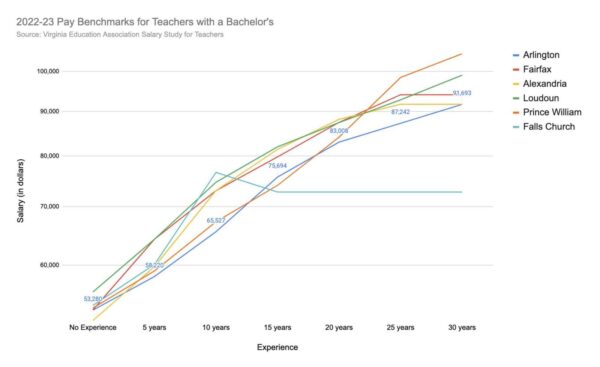
In response to staffing shortages, Durán proposes $2 million for a Summer School bonus for teachers and assistants and increased substitute teacher pay rates and substitute coverage pay for teachers. APS has taken this approach before.
The substitute teacher shortage is not new nor unique to Arlington. About 77% of school systems nationwide report substitute shortages, as teachers retire or quit in higher numbers, a trend some media outlets and research have linked to the pandemic.
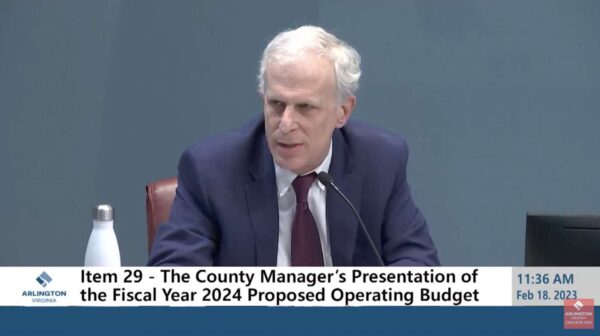
(Updated at 4:20 p.m.) Arlington’s property tax rate will not be going up in the new county budget, but it looks unlikely to come down, either.
The County Board voted unanimously last night (Tuesday) to advertise a property tax rate of $1.013 per $100 in assessed value. That sets a cap on the real estate tax rate, locking in the county to a rate that’s flat or lower than last year.
But homeowners would still see their taxes go up significantly even with the rate unchanged, owing to a 4.5% rise in residential property assessments. Between taxes and fees, the average Arlington homeowner would be paying $454 more to the county compared to the previous year, a 4% increase.
That includes a $100 hike in the annual trash collection fee paid by homeowners — from $308 to $409 — which county officials attributed to a “significant increase to contractual costs due to driver shortages, current labor costs, and equipment pricing.”
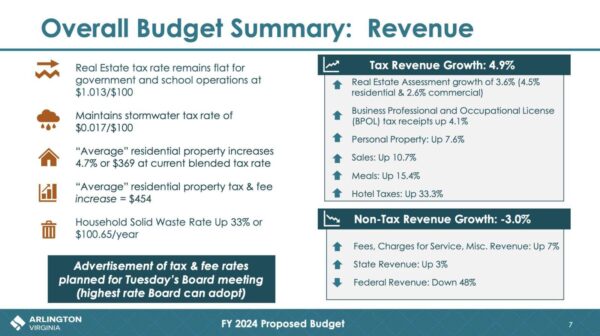
Arlington County Manager Mark Schwartz’s budget proposes keeping the current $1.013 real estate tax rate, despite a better-than-expected revenue outlook.
“The facts have changed since November and December,” Schwartz said, referencing what was then predicted to be a $35 million budget gap. “We’ve seen higher than anticipated real estate assessment growth. I think a number of people saw that when they received their residential real estate assessments in January.”
“On the commercial side, we had anticipated a drop in overall assessments, and there was a very small drop in the commercial assessments, but when you factor in the new commercial buildings the numbers were actually up,” the County Manager continued. “And also, our other taxes… are doing quite well.”
The county is seeing a 10.7%, 15.4% and 33.3% rise in sales, meals and hotel tax revenue, respectively, according to Schwartz’s presentation to the Board on Saturday. After a brutal couple of years for Arlington’s hospitality industry, hotel taxes are now about back to pre-pandemic levels, he noted.
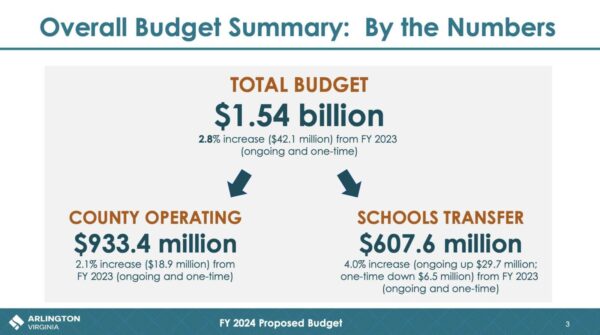
Schwartz’s $1.54 billion budget — up 2.8% over last year’s adopted budget — also includes a number of proposed cuts,
Just over 20 vacant positions would be eliminated, including an auditor position in the County Board office, and other savings would be found from initiatives like paperless billing of property and business taxes. In all, the cuts would save $5.6 million.
While the county is no longer benefiting from the firehose of Covid relief funds from the federal government, it will save $2.6 million thanks to energy credits stemming from its 2020 solar power agreement with Amazon.
In the expense side of the budget, however, the picture is less rosy.
Schwartz said the county is still facing a “very competitive environment in terms of workforce,” making it hard to hire for certain positions and driving up wages. The budget proposal includes a $2,000 bonus for qualified county staffers and 4.5-10% salary increases, including:
- General Employees — 4.5%
- Uniformed Fire — 4.5%
- Service/Labor/Trades — 4.5%
- Uniformed Sheriff — 8.5%
- Uniformed Police — 10%
“We are still having challenges in hiring vacancies,” Schwartz said.
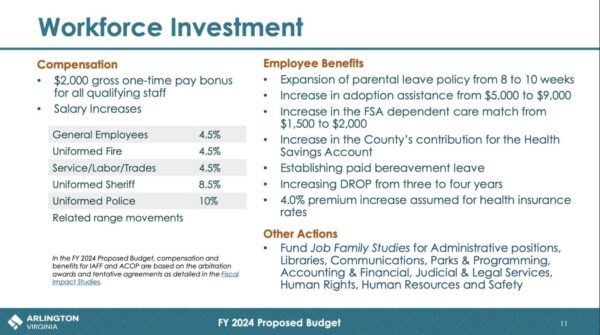
Other initiatives in the budget include purchasing 22 electric vehicles for the county fleet, part of an ongoing transition, and a community engagement effort focused on libraries. The latter will “review the operating model (locations, hours) considering where we’ve seen growth in the County and how that overlaps with service demands.”
However unlikely, there could be flexibility for a slight decrease in the property tax rate. Schwartz left $4.5 million in his budget unallocated, for consideration by the Board.
Starting next week the county will start a series of in-depth work sessions focused on individual departments and offices, followed by public hearings at the end of March and a County Board vote on the final Fiscal Year 2024 budget on April 22.
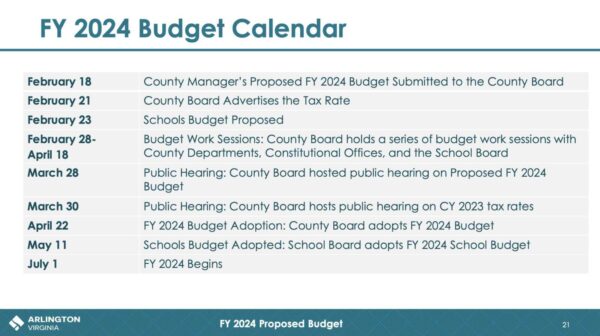
More from an Arlington County press release, below.
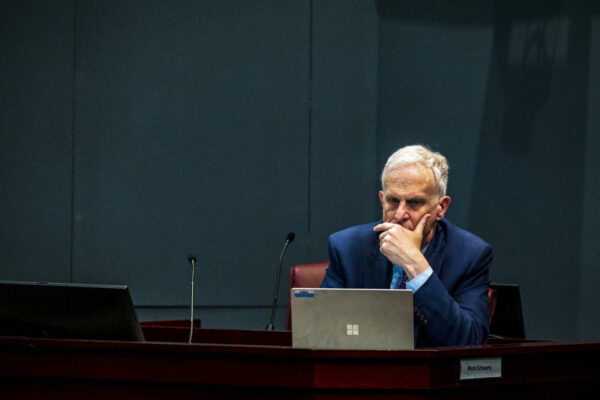
The upcoming Arlington County budget process will be tough, albeit not the toughest, according to County Manager Mark Schwartz.
Schwartz made the remark at the end of Saturday’s Arlington County Board meeting, as the Board discussed its guidance to the manager as he starts work on a proposed 2023-2024 budget.
The backdrop is an economy that may or may not be heading into a recession in 2023, while inflation puts upward pressure on costs — and higher mortgage and office vacancy rates put downward pressure on county revenue.
According to Schwartz and a budget presentation given by staff last month, the county is expecting overall revenue to rise more than $40 million, or 3.4% in the next fiscal year. But inflation, wage growth and other factors are expected to lead to a $35 million gap between expected revenue and county expenditures if current service levels and tax rates are held steady.
That’s on top of the flow of federal Covid relief dollars, which bolstered county finances over the past two years, largely shutting off.
“The revenue picture is tough,” Schwartz told the Board.
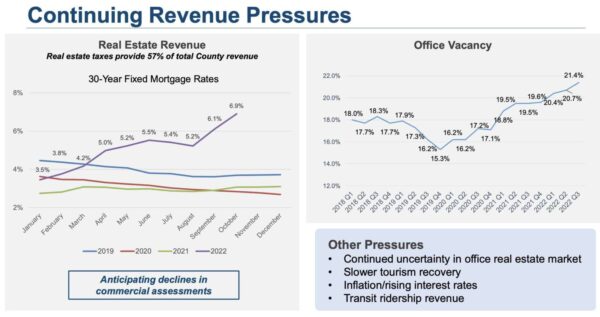
The county is currently expecting a modest 1.9% rise in residential property assessments, which will be mailed out to homeowners in mid-January. And with office vacancies rising, commercial assessments are expected to remain flat.
The office vacancy issue could get even worse over the next few years, Schwartz warned, as long-term leases expire. Office building owners are struggling to fill vacant space amid work-from-home trends, he said, and that will likely result in falling commercial property assessments for much of the decade.
Schwartz said he has “a lot of faith in the long-term resiliency of the economy,” but that it may be rough seas for awhile.
“We’re still transitioning,” he said of the local economy. “We don’t know where we’re transitioning to.”
At the Saturday meeting, the Board adopted budget guidance for Schwartz, outlining priorities including:
- A balanced budget
- Preserving the county’s AAA bond rating
- Budget decisions made with equity in mind
- Funding for collective bargaining with county employee groups
- Continuing to invest in affordable housing, eviction prevention, mental health and environmental priorities
- Maintain ongoing funding of the county’s affordable housing fund
The guidance calls for “actionable strategies for economic development that fully recognize and respond to the impacts of the work-from-home paradigm shift on Arlington’s office vacancy rate.” It also suggests exploring “reductions” and “efficiencies” in the budget and “eliminating programmatic activities that are no longer priorities.”
Schwartz is expected to present his proposed Fiscal Year 2024 budget in February, followed by County Board adoption two months later. Public engagement, work sessions and hearings will be conducted between now and final adoption.
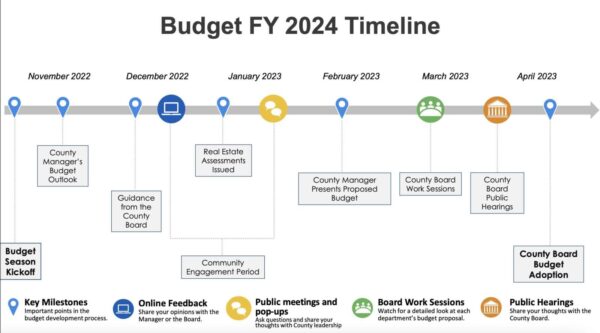
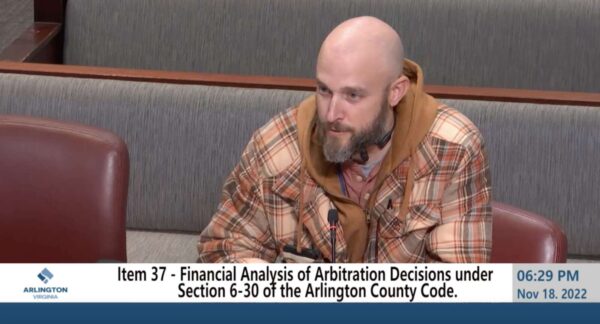
Arlington’s fire and police unions are poised to lose a battle to change the pay scale the county uses — one that union representatives say contributes to ongoing staffing shortages.
This year, the Arlington County Police Department has hired 29 officers and lost 52 officers, Arlington Coalition of Police (ACOP) President Randall Mason told the Arlington County Board in a meeting earlier this month. It will lose five more by February 2023.
“This is the worst staffing crisis we’ve had in 30 years,” Mason said. “Our overtime to make minimum staffing was at 7,000 hours in 2021. It’s on pace to break that this year. The year before that, it was 4,000 hours. We’re right on the verge of mandatory overtime.”
The attrition, due in part to burnout and low morale, has forced ACPD to scale back some services. Amid this trend, last summer the Arlington County Board voted to reinstate collective bargaining for the first time since the 1970s.
For ACOP and the International Association of Fire Fighters (IAFF) Local 2800, the vote meant a chance to renegotiate pay scale structures to keep officers from going to better-paying jurisdictions.
Currently, Arlington County uses an open-range system, which union reps say results in officers with less experience earning more than people of the same rank with more experience. In October, 204 out of 304 ACOP members were paid less than at least one person in their same rank with fewer years of service, Mason said.
“That’s a direct result of the open range system,” he said.
For this reason, ACOP and IAFF are asking for a step scale, which they say is used by most municipalities and more fairly rewards years of service. But this year, the unions and the county reached an impasse regarding this change, among others, and had to go to arbitration.
Unions asked the county to make the switch in one year — a pricy ask the county rejected due to inflation and high commercial vacancy rates putting pressure on its tax revenue and expenditures. ACOP estimates making the switch in one year for police would have cost the county $9 million.
“Just like the fire department, we shot too high,” Mason said. “[But] 66% of officers being paid in an unfair manner isn’t an aberration — it’s something that needs to be addressed.”
Arbiters sided with the county in both negotiations because making the change in one year would be financially unreasonable, but they did indicate their support for a step scale.
“Overall, the weight of the evidence supports the Union’s proposal to move to a step wage structure which will address the problem of salary compression and is in other comparable departments,” writes Samantha Tower, who was the arbiter for the negotiations with the fire department.
IAFF President Brian Lynch told the county Tower did not have the power to provide a middle-ground solution.
“She went out of her way to say there is a better path,” he said.
The Arlington County Board could make a decision on the public safety employee contracts next month. If members approve them as is, they would cement the current pay structures for three more years. The Board could also force county staff and unions to go back to the table and renegotiate.
That’s the path Lynch says he hopes the Board takes.
“With time, your support and the guidance that arbitrator provided… we can make the promise that collective bargaining holds for firefighters in the community we protect a priority we hope you join us in that effort,” he said.

Predicting a potential $35-million deficit in the 2023-24 fiscal year, Arlington County Manager Mark Schwartz recommends putting nearly all of the unspent funds from last fiscal year toward balancing that budget.
Yesterday (Tuesday), the Arlington County Board approved the close of the 2021-22 budget with nearly $26.9 million in unspent, unencumbered “closeout” funds leftover. In the same meeting, county staff briefed the Board on its grim predictions for the 2023-24 budget, planning for which is already underway.
The county attributes the $26.9 million surplus to a better-than-projected tax year and fewer expenses than anticipated.
“This was primarily the result of a slowdown in departmental operations due to COVID coupled with retention and staff hiring challenges,” per a county report. “In addition, Countywide health care costs were less than anticipated.”
The 2022 closeout funds represent 2.4% of the county budget (excluding Arlington Public Schools expenditures) and mark an increase from last year, when the county ended the 2021 fiscal year with $20.4 million — or 2.2% of the budget — leftover.
Those closeout funds, coupled with federal funding, went to pandemic recovery, childcare, criminal justice reform and other equity initiatives. But now, Schwartz says the county needs the 2022 closeout funds for balancing the budget.
“Given the pressures that we’re facing in fiscal year ’24… my recommendation is that the discretionary balance of [$26.9] million that is available in closeout be set aside so that the board can consider it for potential use as part of the fiscal ’24 budget process,” Schwartz said on Tuesday afternoon during an Arlington County Board meeting.
Arlington County Budget Director Richard Stephenson said the projections are not uniformly bad news.
“It’s a good news, and not-so-good news, story,” he said. “County revenue that we’re projecting for 2024 is positive. Unfortunately, as we’re looking ahead, the expenditure side of the equation is going to outpace the revenue growth we’re projecting.”
Total tax growth is projected to be up 3.4% before sharing revenue with Arlington Public Schools. That is driven by increases in real estate assessments as well as taxes on personal property, Business, Professional and Occupational Licenses, sales and meals.
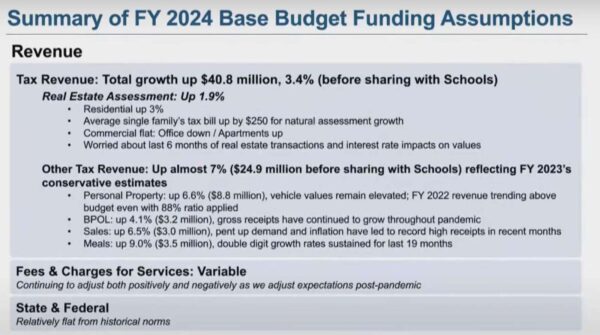
Another bright spot, Stephenson said, is that sales and meals taxes have not only bounced back from the pandemic, but they have also surpassed pre-pandemic levels. He said the county expects the hotel tax will eventually catch up, too.
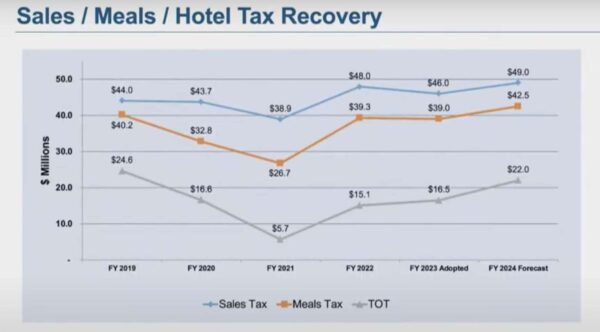
Still, Stephenson said, said the county has a number of “self-evident” concerns at the start of budget planning for the 2023-24 budget: inflation and wage growth, the transition from one-time federal funding — from sources such as the American Rescue Plan — to ongoing local funding for some projects, and the impact of interest rates.
Climbing interest rates and office vacancy rates, however, are threatening a “significant portion” of Arlington’s General Fund budget, or revenue from commercial real estate tax, Stephenson says.
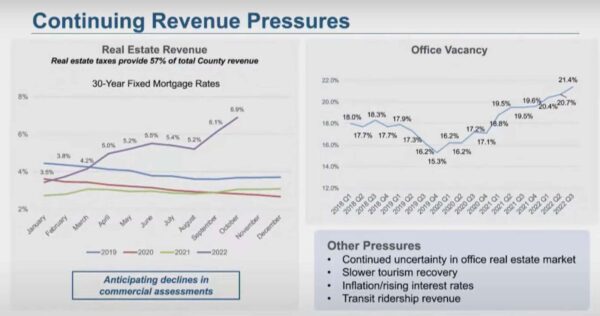
Arlington County Board Chair Katie Cristol said this information “gives a good bit of context” to Schwartz’s recommendation to lean on unspent, unencumbered “closeout” funds next year.
“For my part, I do think this is an easy decision to carry the fiscal ’22 closeout to fiscal ’24, and that may be the last time the term ‘easy decision’ is used in the same sentence as ‘fiscal ’24 budget,'” she said.
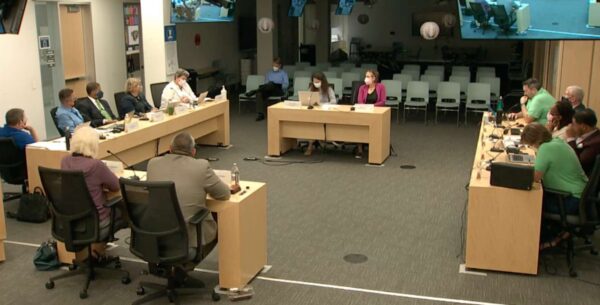
(Updated at 4:15 p.m.) An advisory group meant to guide facilities planning has several concerns with Arlington Public Schools’ proposed capital spending plan, namely the cost of a new Arlington Career Center.
APS would only be able to construct the Career Center by nearly maxing out its debt capacity, according to a Joint Facilities Advisory Committee report published June 7.
The county and APS cap debt repayments at 10% of their projected budgets. Under the School Board’s proposed CIP budget, the debt service is expected to remain around 9.8% from fiscal year 2027 to fiscal year 2032, according to JFAC’s report, leaving little wiggle room for maintenance projects and unforeseen needs.
At the same time, the CIP contains “discrepancies in the accounting for available bonding capacity for APS,” JFAC says.
The group Arlington Parents for Education explained in a newsletter today:
APS shares bond capacity with the county. This week, it was revealed that the county has a very different idea of how much APS has available in bond capacity; the County’s CIP has only $78 million in available bond capacity for APS. This is a discrepancy of $242 million.
“The main concern of JFAC is this CIP in the broader context all the known facility and infrastructure needs of APS and ACG,” JFAC’s chair and vice chair wrote in a recent letter. “It presently does not transparently demonstrate long-term financial viability for short term projects and expenditures or demonstrate that long-range planning processes for land use or capital projects have been fully considered.”
The lack of transparency “makes it harder for the public to recognize the planning commitments APS is making in this CIP,” the committee report stated.
However, APS believes it is being fiscally prudent.
“I don’t think we have anyone on this School Board or anyone on the staff is recommending that in the out years, we bump our CIP up to the maximum 9.8% target that we used to come up with that bonding capacity. It was just to show that there is room available in the out years for other projects that will come in those next CIPs,” said Assistant Superintendent Leslie Peterson during a work session reviewing the committee report.
The proposed CIP was also vague on the details of how the capital projects would be funded, the JFAC report said. The proposed budget did not set a specific amount of funding for long-range plans to renovate existing facilities, nor did it account for their cost estimates in setting its desired bond capacity, according to the report.
The School Board and county government projections for bond capacity are also at odds, with the School Board budgeting $242 million more than the county.
School Board Chair Barbara Kanninen said bond capacity may open up if the county — and, by extension, APS — receives more revenue than what was projected, allowing the board to carry out all the identified projects. If that doesn’t happen, the School Board would then discuss how to best handle new capital spending needs.
“If that’s the way it is, we’re gonna have that conversation then, there’s no pre-having that conversation,” she said.
The proposed CIP estimates the new Career Center building, which would be the most expensive project the school system has ever undertaken, would cost around $174 million. It would be funded by about $136 million from a 2022 bond referendum, as well as $37.4 million in past bond funding.
The JFAC report expressed concern at this decision since the School Board would be asking for a large sum of money at “a time of high inflation and financial uncertainty.”
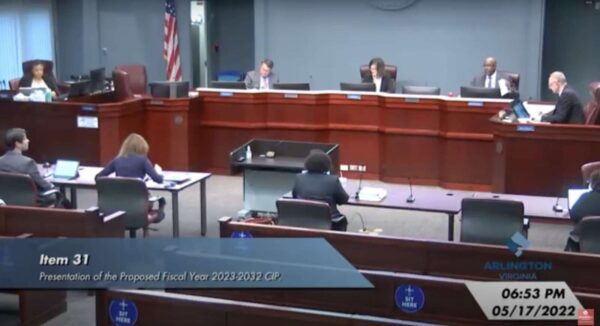
From a new Columbia Pike library to a dedicated pickleball court, County Manager Mark Schwartz’s proposed 10-year $3.9 billion capital improvement plan would fund projects across Arlington.
The first 10-year plan for capital projects in four years would budget for infrastructure projects between 2023 and 2032. The CIP proposal, slated for adoption in July, is a 40% increase from the plan approved four years ago, Schwartz said in his presentation to the County Board Tuesday.
“This CIP proposal aims to address current and future capital needs in Arlington County as we emerge from the financial setbacks caused by the COVID-19 pandemic,” Schwartz said in a statement. “We want to focus on key planned investments in addition to following through on commitments from prior plans to benefit county residents and businesses long-term.”
Stormwater projects would receive $331.3 million in funding, including $77 million for Spout Run, $14.7 million for Torreyson Run, $28.5 million for Crossman Run and $49.5 million for Lubber Run — all flood mitigation efforts. Streams and water quality funding is proposed at $52.1 million and maintenance at $50.2 million.
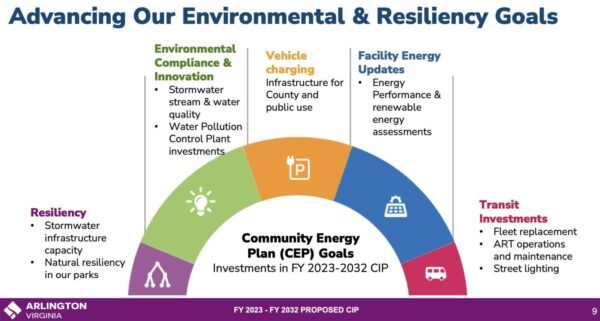
While Metro remains one of the largest investments in the CIP, at $356.4 million, the proposal also outlines $1.8 billion in non-Metro transportation funding. This includes $16 million for Vision Zero street safety improvements program, $64 million for bridge replacements and renovations, and $89 million for bike and walk programs.
Other highlights include:
- Columbia Pike library replacement ($31.6 million)
- Planning for future investment at the Quincy Street site ($16.4 million)
- Army Navy Country Club Trail ($4.9 million)
- Maintenance and expansion of Capital Bikeshare program ($16.8 million)
- Continued funding for Columbia Pike transportation improvements, supporting the remaining reconstruction and the Transit Station program ($117 million)
- Bridge replacements and renovations, including replacing the W. Glebe Road and Mt. Vernon (Arlington Ridge Road) bridges and design and construction of Shirlington Road Bridge ($64 million)
- Construction of new entrances to the Ballston ($147.5 million) and Crystal City ($91.4 million) Metro stations and investment in the transitway extension to Pentagon City and Potomac Avenue ($33 million)
The proposed CIP includes new park programs that focus on emerging needs and natural resiliency, a new fire station on the west end of Columbia Pike, and facilities consolidation to enable remote work for county staff.
Schwartz said the needs of the county have changed since the last 10-year CIP, as the county is in “a world shaped by the pandemic where we do our business differently.”
Michelle Cowan, deputy county manager overseeing the Department of Management and Finance, noted during the presentation that the finance department works entirely remotely now, potentially a harbinger of a money-saving reduction in the county’s office footprint.
“We have reduced our footprint which… allows us then to do some really strategic consolidations that you’ll hear about in other county buildings that could get us out of some aging assets,” Cowan said.
The CIP will continue to fund debt service obligations for the investment in housing at Barcroft Apartments, construction of Fire Station 8, which is scheduled to be completed in fall 2023, and the design and planning process for the proposed Arlington boathouse.
Preliminary construction funding for the lower boathouse site is included in the later years of the CIP.
This CIP returns funding levels for the Arlington Neighborhoods Program, formerly the Neighborhood Conservation Program, which are projects identified by individual neighborhoods and include street improvements, streetlights, parks, beautification and sidewalks. The program had steep cuts in previous CIPs.
The 2023-32 CIP proposal would provide $85.2 million in funding to the program. That includes $4 million of funding for projects in fiscal years 2023 and 2024, and would increase to $9 million in 2030 and 2031, Director of Management and Finance Maria Meredith said.
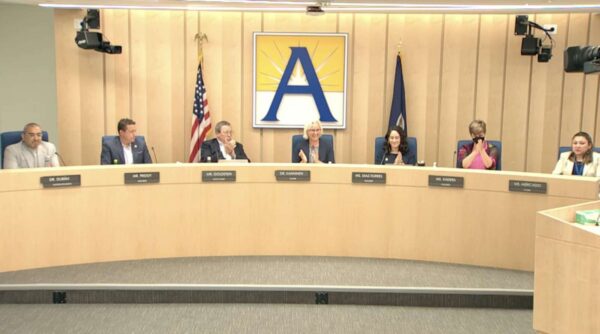
The Arlington School Board unanimously approved a $749.9 million budget for the 2022-23 school year during its meeting Thursday night.
Revenue for the Fiscal Year 2023 budget includes a $563.8 million ongoing transfer from the county, a one-time transfer of $20.5 million, $3.5 million in carry-over funds from the 2021-22 school year, state and federal funding, and the use of $21.3 million in reserves.
The budget process, Chair Barbara Kanninen noted, went well. It was the first time in four years that the School Board was presented a balanced budget — as opposed to recent years when the superintendent proposed spending more than was anticipated in revenue.
Similar to the county budget, school system funding in the upcoming year emphasizes compensation for staff.
“We want to support our students as much as possible but a big part of that is recruiting and retaining that outstanding staff,” Kanninen said.
The budget will allow the school system to begin implementing its new compensation plan, which will update salary scales, provide consistent step increases and catch up from missed missed step increases in the past. On average, teachers, principals and administrators will see a 6.8% pay increase, while support staff will see an average of a 9.5% increase.
School Board members Mary Kadera and Cristina Diaz-Torres said when they first heard the proposed compensation increases, they thought it would be a “moonshot.”
The budget reduces class size by two students at the elementary level and one student at the high school level, funds additional school-based equity and excellence coordinators and an equity data dashboard, and adds more resources for English learners.
Adjustments to school bell times, which were also approved at the meeting, are expected to result in nearly $2 million in savings for the school system. The changes reduce the number of school start and end times from eight across APS to five, thus streamlining school bus routes and schedules.
The School Board added to Superintendent Francisco Durán’s proposed budget, including funding for four psychologists and social workers, trauma-informed professional learning, the National Board Certified Teacher program, a partnership coordinator, and a math curriculum supervisor.
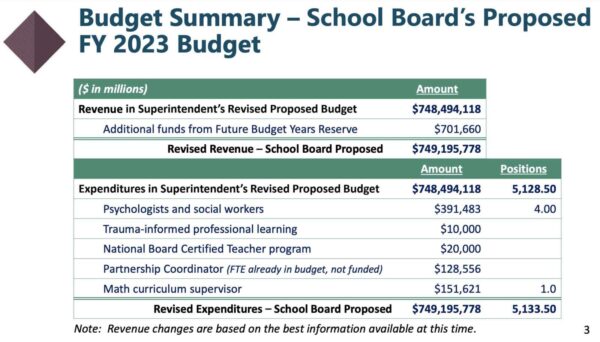
Other updates to the budget included $147,871 in funding to open the planetarium in October or November 2022 and hire a director, $391,484 for four high school math coaches and $628,000 for a year of tutoring for grades 6-12.
A few public commenters noted the disparities in minority students’ test scores and the need for more funding to compensate for lost learning during the pandemic.
“We took a first step, we have more steps to go until we see each and every one of our students be successful and right now we have a lot of students that are still having some academic and social emotional needs,” Durán said in response.
The Virginia General Assembly still has not adopted a budget for the Commonwealth, so the School Board will likely have to amend the budget to account for any state revenue changes. If there’s a shortfall, the superintendent proposes to fund them with reserves.
Capital Improvement Plan (CIP)
The School Board also kicked off its Capital Improvement Plan process, as Durán put forward his proposal, which totals $388.23 million between 2023 and 2032.
The CIP will be the first 10-year plan since 2018. The school system has only budgeted three years in advance since, in part due to budgetary uncertainty during the pandemic, but can return to the longer range planning now that APS is in a better place fiscally, Durán said.
All proposed project funding includes money set aside for escalation and inflation, as well as contingency.
While about 45% of the CIP will go toward the Arlington Career Center project, Durán said his proposal incorporates many other improvements. He proposed the larger of the two concept options for the career center, which could accommodate 1,795 students. The center is the county’s only career and technical education center.
“This is a major part of our CIP, certainly, but not the only one,” Durán said.
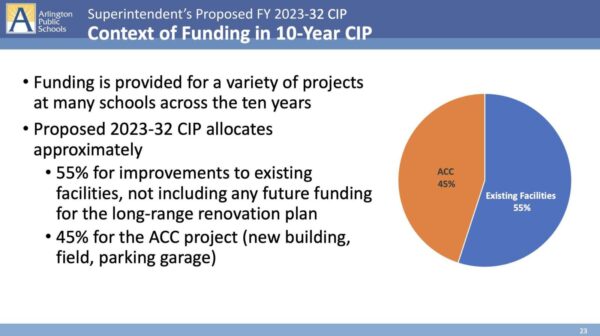
His presentation to the board also highlighted kitchen upgrades, security vestibules at schools, athletic field replacements and accessibility enhancements.
The first school renovation would have a target fall 2026 start — but the school system hasn’t determined which school will be upgraded.
In the proposal, new synthetic turf would be installed at Wakefield High School in fiscal year 2023, at Washington-Liberty High and Williamsburg Middle School in fiscal year 2024, and at Greenbrier Park (Yorktown High School) in fiscal year 2025. Kenmore’s field will also be converted but costs will be shared with the county, Durán said.
An HVAC replacement at Barcroft Elementary School is under design and Randolph Elementary’s roof replacement will go to bid this fall.
Other items included in the proposal were upgrades to finance and HR staff software, known as STARS, replacing lock and key systems, and PA system replacements at six schools.

